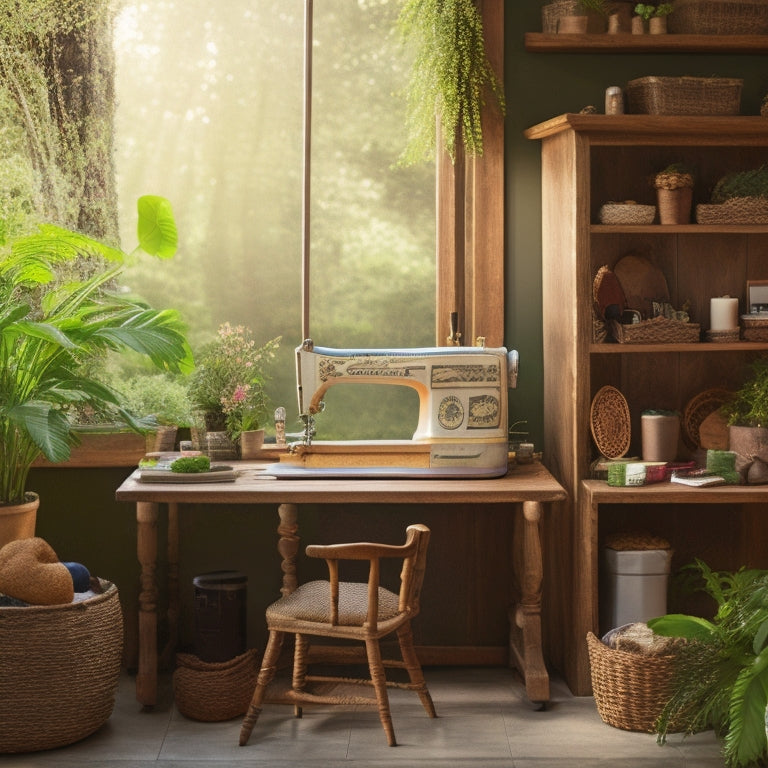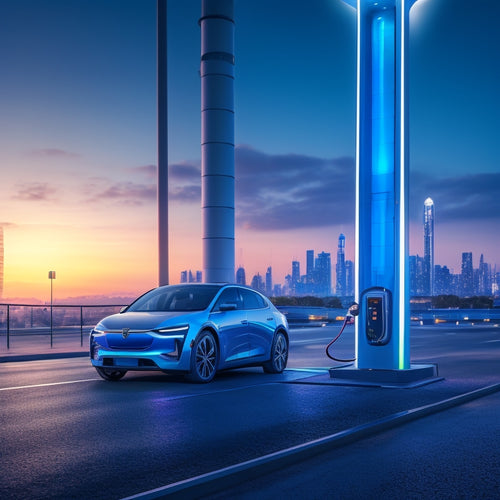
Eco-Friendly Organization: Solar-Powered Crafting Solutions
Share
You're looking to create a more eco-friendly organization, and solar-powered crafting solutions can help. By harnessing solar energy, you can reduce your reliance on non-renewable sources and minimize your carbon footprint. To take it to the next level, opt for eco-friendly materials like natural fibers, recycled textiles, and repurposed items. Solar-powered tools can further minimize your environmental impact. By adopting mindful consumption habits and embracing sustainable practices, you'll not only reduce waste but also create unique, eco-friendly crafts. As you continue to explore the world of green crafting, you'll uncover innovative solutions to help you stay ahead of the curve.
Key Takeaways
• Harness solar energy to power crafting tools and reduce reliance on non-renewable energy sources.
• Choose eco-friendly materials, such as natural fibers, recycled textiles, and repurposed materials, to minimize waste and pollution.
• Regularly maintain solar-powered tools to ensure peak performance, including cleaning solar panels and checking battery life.
• Adopt mindful consumption habits and rethink the crafting process to minimize environmental impact and maximize sustainability.
• Join a community of eco-friendly crafters to access cutting-edge tools, resources, and innovative solutions for a sustainable future.
Harnessing Solar Energy for Crafting
To effectively harness solar energy for crafting, you'll need to understand the basics of photovoltaic cells and how they convert sunlight into electrical energy.
As a crafty individual, you're likely interested in exploring sustainable practices, and solar power is an excellent way to reduce your carbon footprint.
Solar Artisans, who specialize in energy harvesting, can guide you in designing and implementing solar-powered systems tailored to your crafting needs.
By leveraging solar energy, you'll not only reduce your reliance on non-renewable energy sources but also enjoy the independence that comes with generating your own power.
Eco-Friendly Crafting Materials Matter
You're likely aware that the environmental impact of your crafting extends beyond the energy you use, and the materials you choose play a significant role in reducing your ecological footprint. The materials you select can either contribute to or mitigate waste, pollution, and resource depletion. To make a positive impact, consider using eco-friendly materials like natural fibers, such as hemp, bamboo, or organic cotton, which require less water and pesticides. You can also opt for recycled textiles, reducing waste and conserving resources.
| Material | Environmental Benefits |
|---|---|
| Natural Fibers | Low water and pesticide use, biodegradable |
| Recycled Textiles | Reduces waste, conserves resources, and decreases pollution |
| Repurposed Materials | Reduces waste, promotes creativity, and decreases pollution |
Solar-Powered Crafting Tools Essentials
By harnessing the power of the sun, you can now craft with a clear conscience, thanks to innovative solar-powered crafting tools that minimize your reliance on non-renewable energy sources.
As a member of crafting communities, you're likely aware of the importance of sustainable practices. Solar-powered tools are an essential step in reducing your carbon footprint.
To guarantee peak performance, regular tool maintenance is vital. This includes cleaning solar panels, checking battery life, and storing tools properly.
By following these simple steps, you can prolong the lifespan of your solar-powered tools and continue creating with a clear conscience.
Join the growing community of eco-friendly crafters and take control of your environmental impact.
Crafting With Sustainable Practices
As you commit to crafting with sustainable practices, you'll find that incorporating eco-friendly materials and minimizing waste become second nature.
You'll adopt mindful consumption habits, carefully selecting materials that reduce environmental impact.
You'll also develop a talent for creative repurposing, transforming discarded items into unique crafting materials.
This mindset shift will inspire you to rethink your crafting process, from sourcing materials to managing waste.
By adopting sustainable practices, you'll reduce your carbon footprint and create crafts that not only bring you joy but also contribute to a more eco-friendly future.
As you refine your sustainable crafting skills, you'll become a master of reducing, reusing, and recycling, making a positive impact on the environment.
The Future of Green Crafting
In the next decade, experts predict that green crafting will evolve into a highly sophisticated and innovative industry, driven by technological advancements in sustainable materials and production methods.
You'll witness a surge in Crafting Communities that prioritize eco-friendly practices, driving the Green Revolution forward.
As a crafty individual, you'll have access to cutting-edge tools and resources that minimize waste and maximize sustainability.
Imagine creating intricate designs with 3D-printed recycled materials or harnessing solar power to fuel your creative pursuits.
The future of green crafting holds immense potential, and you're at the forefront of this transformative journey.
Frequently Asked Questions
Can I Use Solar Power for Crafting in Areas With Limited Sunlight?
You can still harness solar power for crafting in areas with limited sunlight by using shade solutions like concentrated photovoltaic systems, which maximize energy output even on cloudy days.
Are Solar-Powered Crafting Tools More Expensive Than Traditional Tools?
You'll likely pay a premium for solar-powered crafting tools, due to the "green premium" effect, which means they're often more expensive than traditional tools, but a cost comparison reveals long-term savings through reduced energy costs.
How Do I Properly Maintain My Solar-Powered Crafting Equipment?
To maintain your solar-powered crafting equipment, you'll want to guarantee dust protection by regularly cleaning vents and filters, and conduct regular inspections to identify potential issues before they become major problems.
Can I Use Recycled Materials for Crafting and Still Call It Eco-Friendly?
You can absolutely use recycled materials for crafting and still call it eco-friendly, as long as you're mindful of material sourcing and engage in creative repurposing, reducing waste and minimizing environmental impact.
Are There Any Certifications for Eco-Friendly Crafting Organizations?
You'll find that, yes, there are certifications for eco-friendly crafting organizations, such as Eco Labels and Green Badges, which verify your commitment to sustainability, providing credibility and assurance to environmentally conscious customers.
Related Posts
-

Why Cheap Solar Panels Aren't Always the Best
When opting for cheap solar panels, you're likely sacrificing quality and reliability for upfront savings. However, y...
-

5 Tips for Efficient Last Mile EV Delivery
You're looking to supercharge your last mile EV delivery operations. Start by optimizing your fleet operations to red...
-

What Does EV Charging Station Installation Cost?
You can anticipate paying between $300 to $1,500 or more for an EV charging station installation, depending on the ty...


